Do you have fish that like digging into the substrate and are destructive enough to uproot the plants on the substrate? Or do you have fish that prefer a low-light environment?
If you do, don’t worry! Today, you’ll get 15 floating aquarium plants that can better solve these problems. Read this article and try to choose the one you like best!
The benefits of adding floating plants to your aquarium
If you ask what actions are beneficial to your aquarium, the first thing that comes into my mind will be adding plants. Plants are helpful in fish keeping, so what are the exact benefits you can get by adding floating plants to your aquarium? The answers are as follows:
1. Enhance the aesthetics of your aquarium
If you want to decorate your aquarium, adding floating plants may be a good choice. They can mimic the natural environment and provide your aquarium with a more natural look. What’s more, most floating plants are green, which means you can add more colors to your aquarium and make it more ornamental.
2. Diffuse and block the light
Floating plants can diffuse and block the light since they float on the water surface and most lights are above the aquarium.
Some fish live in shady areas in the wild and are sensitive to light. Being exposed to too much light will make them get stressed.
However, with some floating plants, you can avoid the stress of light and also provide your fish with an environment that is similar to their natural habitat.
3. Add oxygen to your aquarium
Fish need oxygen to survive. However, it’s difficult for them to get oxygen from the air since they can not survive long out of the water, so we should oxygenate the water to make sure the oxygen supply.
Among all the methods used to add oxygen to an aquarium, using plants may be one of the easiest ones. Plants are born to intake carbon dioxide and release oxygen, which is the process of photosynthesis.
4. Help remove some toxins in your aquarium
Poor water quality is detrimental to the health of your fish. Ammonia, nitrates and nitrites are toxins that are invisible but harmful components that lead to poor water quality. You may need to use filters and water changers to keep the water clean.
Nevertheless, you can also use the floating plants to remove those toxins. They will absorb these toxins and use them to fertilize themselves. By doing this, they help reduce the workload of the filter as well as yourself.
5. Provide shelters for the creatures in your aquarium
Hiding places are necessary for fish to feel safe and comfortable. Some fish are shy in nature and love hiding. Most fish will hide when they perceive aggression, stress, threats and dangers.
During pregnancy and delivery, female fish need hiding places to make sure the safety of themselves and their babies.
In addition to the rocks and caves in your fish tank, floating plants can also serve as shelters.
You may wonder how can floating plants provide shelters for fish since they are on the surface. Well, most floating plants have long roots, which will stretch out into the water and create shelters for fish.
6. Provide food for the creatures in your aquarium
Some fish are herbivores or omnivores that be fed by plants. When you forget to feed them or don’t give them enough food, they can go for the floating plants as a food supplement.
15 best low-maintenance floating aquarium plants for your tank
1. Azolla

Azolla, also known as Mosquito fern, needs bright light to grow and once you can meet its demands, keeping it can be very simple. It is easy to reproduce and grow fast in the water.
The most important thing is that it can serve as fertilizer and food for fish. It is more suitable for the larger fish tank since the water surface can be wider, which means a larger opening area.
2. Cabomba
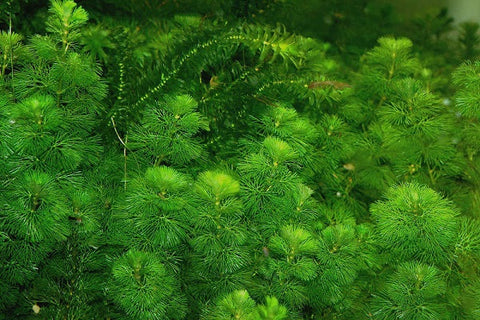
Cabomba, also named fanwort, has a fantastic outlook but is difficult to maintain compared with other species in our list. Unlike other plants that can survive easily in the water, Cabomba needs some fertilizers to healthily grow.
But they are still popular among aquarists, especially those who have fish fries and shrimp. This kind of plant can also help remove nitrates in your fish tank. So if you think you can handle this, add some to your aquarium!
3. Anacharis
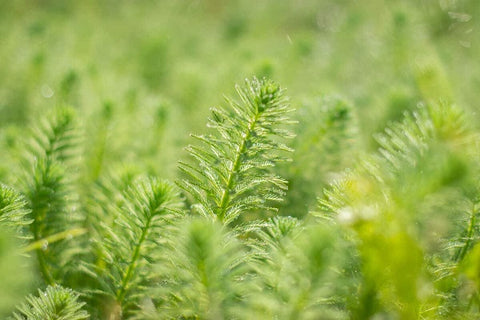
Maintaining Anacharis can be easy for all aquarists. Without much attention, it can grow quickly and fulfill the water surface. It isn’t sensitive to water conditions, so you don’t have to worry that it will die or rot because of poor water conditions. But it does need much light to grow, during which it can provide oxygen to the water.
4. Hornwort
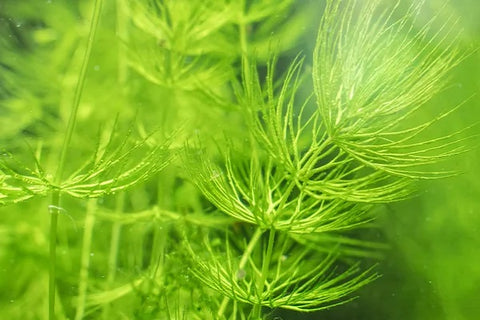
You can plant hornwort on the substrate or let it float on the water surface. They are easy to grow and don’t require too much light. If you keep the light on for a long time or the light is too strong, they will overgrow and cove the water surface, some even grow out of the tank.
And their leaves are so thin that they can clog the filters in your tank. So you need to trim them regularly and maintain a medium or low light level.
5. Java Moss
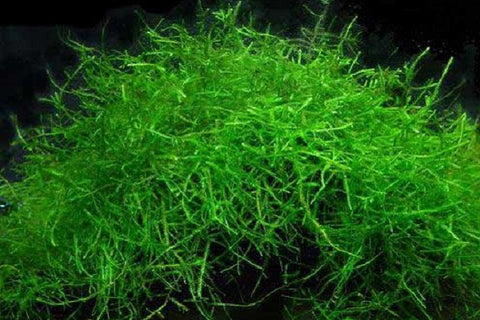
It is always seen with substrates, rocks or driftwood, but it can also float on the water surface. A standard light level is enough to grow java moss in your tank. They can survive in any environment and won’t grow too fast to bring trouble.
If you plan to breed your fish, I’ll recommend java moss to you, which can offer a place for the female fish to lay eggs and for the fries to hide from.
6. Duckweed
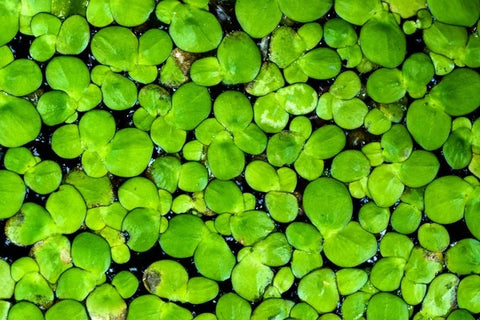
Duckweed is one of the most popular and also one of the fastest-growing floating plants. It can bear any light levels and will block the light once occupying the whole surface. So the fish you are keeping need light, the duckweed is not your option.
Moreover, you need to remove some of them regularly if you don’t want to see a “duckweed cover” in your fish tank.
7. Water Sprite
![]()
It is a floating plant that can offer many hiding spots for fish need to hide. Like most floating plants, it also doesn’t need much care, so you won’t spend too much time on maintenance. But it doesn’t mean you can ignore it, after all, there is an occasion that it overgrows.
8. Rotala Indica
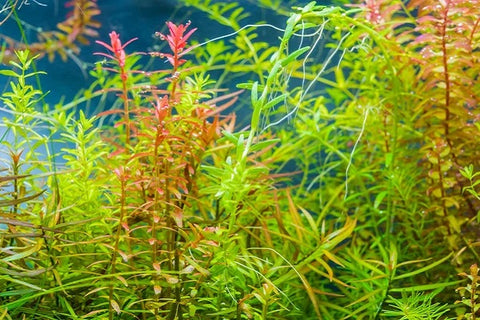
Rotala Indica can also float on the water surface as well as grow on the substrate. The color of its leaves will change with time passing by, which makes it unique in these 15 floating plants. To healthily keep this plant in your fish tank, an adequate light supply is necessary.
9. Water Wisteria
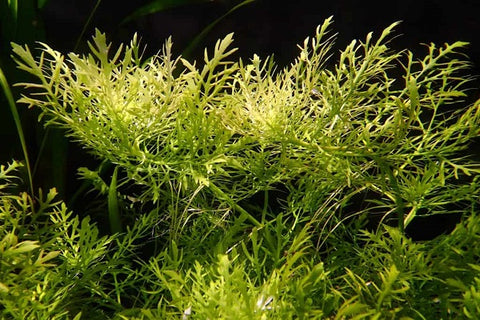
Water wisteria can provide a large shade for your fish with its big leaves. It can be planted on the substrate but does well when floating on the water surface.
It can grow very fast and occupies the whole water surface, even grow out of your tank. Add trimming water wisteria to your schedule if you don’t want to see this happening.
10. Water Spangles
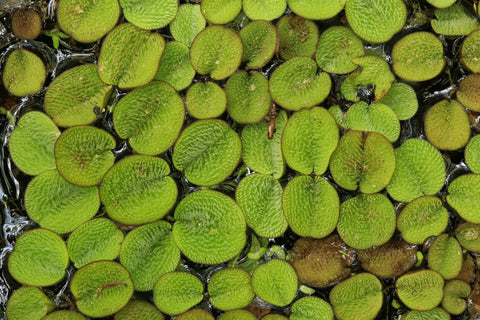
Water spangles are good at blocking lights and providing shades. If your fish come from shady areas and prefer a dark environment, adding water spangles would be a good decision.
It is a hardy plant that can do well in poor conditions, and that’s why it’s a recommendation for beginners. It has flat and big leaves to provide places for egg-laying, hiding, and eating.
11. Amazon Frogbit
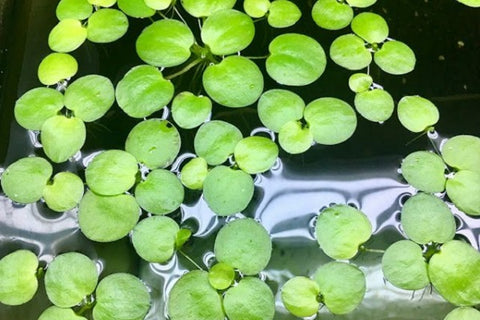
Amazon frogbit has a long root and wide, flat leaves that can block the light and provide shelters for live stocks. It’s very hardy and can survive in different environments.
Keeping Amazon frogbit in an aquarium can be easy because of its low maintenance and low requirement for light. But you should keep an eye on it to avoid overgrowth.
By the way, it is one of the most suitable floating plants for beginners, so if you are new to this hobby, do not hesitate to buy one!
12. Ludwigia Repens
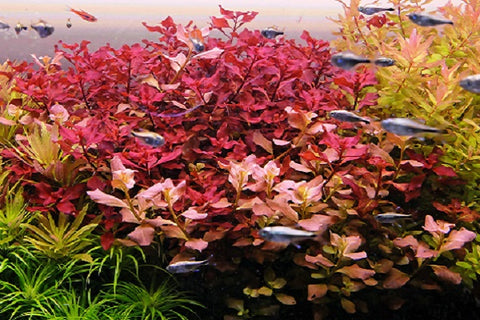
Most floating plants among these 15 species are green, but this plant is different, it is red and brown. If you want to add different colors to your aquarium, add this to your list. You don’t need to spend too much time on it except for the trimming once you provide adequate light and some nutrients for Ludwigia Repens. Very simple and easy to maintain, right?
13. Red Root Floater
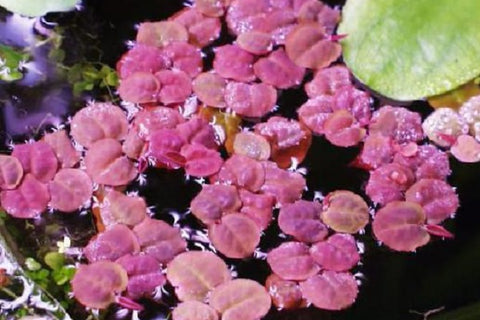
As the name implies, the root of this plant is red. If you want the leaves to be red, you need to offer much light to them, which will lead to outgrowth. With a lower light level, the leaves will be green or yellow, and the frequency of maintenance will reduce. It’s up to you! Anyway, they are easy to grow and very beautiful.
14. Dwarf Water Lettuce
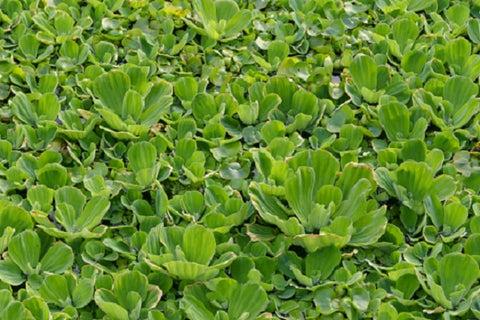
Although its name is lettuce, it is not real lettuce. It gets its name from its appearance, which is similar to the vegetable lettuce. You should be mentally prepared if you decide to plant dwarf water lettuce in your aquarium. It will grow rapidly and is difficult to remove.
Warning: keeping dwarf water lettuce personally is illegal in some countries, so do not forget to check the law first before you buy some for your aquarium.
15. Floating Bladderwort
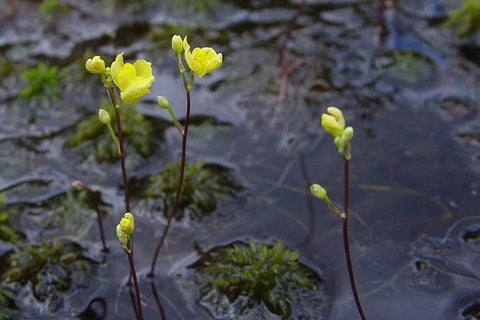
The floating bladderwort is different from the other 14 floating plants in appearance, so if you are bored with other species, you can try this one. With enough sunlight, you will get a flower that varies in color. More importantly, it doesn’t need much maintenance and is easy to take care of.
How to choose the best floating plants for your aquarium?
Now that we have known 15 the best low-maintenance floating aquarium plants, so how to choose the best one for our aquarium? The selection of floating plants depends on many factors, including tank size, fish species, lighting level and so on.
How big is your tank?
The size of your tank determines which kind of floating plants can you have. If your tank is small and has little spare room, you’d better not add plants to it.
If you have enough room for plants, you should avoid those that grow fast or your tank will get overstock quickly. But if you have a big tank and much opening space, you can ignore this factor.
What fish do you keep in your aquarium?
The fish species also matter in floating plants selection. For example, for fish that have a high demand on lighting level, you’d better not add too many plants, whether on the surface or the substrate.
But if your fish prefer a dark environment and need many hiding spots, floating plants can help a lot. Also, the diet, living levels and temperament will influence the choice of floating plants.
The lighting level you can provide
If you’ve already equipped an aquarium light on your fish tank and do not intend to replace it or buy another one, you should check how much light can the light provide. According to the result, you can choose the plant that can survive under your light’s level.
How fast do they grow?
Well, this factor is about how diligent you are. If you are happy to check and trim it regularly, even on a daily basis, you can pass it. But if you feel annoyed with the maintenance, you should choose those that grow more slowly.


Comments (0)
Back to Beginner Guide & Advice